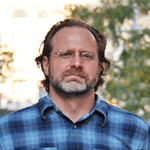 gb&d: How did you get started designing lighting?
gb&d: How did you get started designing lighting?
Derek Porter: I didn’t actually study lighting design; I kind of happened into it. I earned a degree in fine arts from the Kansas City Art Institute where I became interested in human perception and spatial relationships. The subtle qualities of space and human response intrigued me. I enjoyed architecture and eventually started working with an architectural lighting designer where I discovered the significant impact light can make. Seven years later, I started my firm with the intent of expanding my interest and experimentation with light into new domains.
gb&d: You study light and space through photography and sculpture. How does this show up in your designs?
Porter: It’s a very different framework for investigating light than typically found in design practice where a consultant’s primary focus is to address project needs. My artistic pursuit allows freedom from such practical constraints and an increased slowness to explore spatial relationships and subtle nuances of light in the built and natural world. This results in a very different vantage point and a soft voice that subconsciously is felt—its essence is what comes across.
gb&d: What is the goal of lighting?
Porter: On a base practical level, lighting allows us to perform tasks, but its application should be considered beyond sole practical issues. I’m involved in academia, where I pursue design-based research and larger intellectual interest in lighting design—how it contributes to the world and how it affects life. I toggle between academia and my practice as a means to question, test, and I use my practice to push against traditional ideas and challenge hypotheses. When I enter a project, I bring to the table this cache of study and intrigue that adds value. We solve problems and work with real constraints, but I believe that our company is different because we apply solutions through a broader lens of what light is, how it defines space, and an awareness of the world we occupy.

Clerestory windows bring daylight into the Grand Ballroom of Kansas City’s convention center’s Bartle Hall through large light monitors. The taut architectural fabric filters direct sunlight to diffusely illuminate the space without the aid of electric lighting. Photo: Michael Spillers
gb&d: How did you get started teaching at Parsons The New School for Design?
Porter: Like a lot of people who teach, I had an interest in sharing and exploring ideas in the classroom through reformatting one’s own ideas and interests. It’s an inspiration to be in the presence of young, creative, hungry minds, to witness their growth and contribute to their and the industry’s future. Having a broader contribution to the lighting-design industry, expanding its intellectual capacity, and influencing its future is what ultimately motivates me to teach.
gb&d: What are some of the most important lessons that you teach at Parsons?
Porter: I’m interested in showing students that lighting is one piece of a multiple-part, holistic approach to designing the built world. It involves design-based research, evaluation of precedent case studies, and practical problem solving, and through this process, the evolution of each individual’s unique voice.

Porter took this photograph of Lake Michigan to capture atmospheric qualities of light, using a long exposure to abstract any recognizable details. These artistic explorations heavily influence his approach to lighting in practice.
gb&d: Tell us about a favorite project.
Porter: A project that comes to mind that I believe epitomizes the work we do is a self-storage facility in a blighted urban area in Topeka, Kansas. The developer was interested in the social value of this project as a financial anchor for community improvement. We were careful to look at the surrounding industrial context so that a perception of change would be recognized. The project needed a welcoming beacon-like quality of hope and future prosperity. We needed it to be luminous without harsh qualities of glare that was common to the area. On a practical level, we had strict limitations to meet a tight budget with low-tech solutions, but we used these limitations to drive the design. The end design used basic fluorescent strip lights in three variations with one type of light bulb throughout. Rather than the lighting being a pattern on the ceiling, it was folded into the architecture to create a billowy lantern-like quality, which required a great deal of collaboration with the architect and engineer. Social and aesthetic aspirations aligned with all the logistical constraints and yielded a project of value to the community.

Self-storage facilities typically aren’t answers to urban blight, but this one in Topeka, KS, lit by Porter, evokes a gently playful presence that functions as a beacon of hope for an economically depressed area. Photo: Mike Sinclair
gb&d: What’s next for Derek Porter Studio?
Porter: I tend not to be a planner. I don’t have any grand plan or scheme; more often I work through opportunistic endeavors that present themselves through my constantly evolving journey. One venture that I’m excited about is working with manufacturers to develop lighting products. My ambition has to do with developing instruments that engage interior space or landscape environments in a way that’s unusual, fresh, and provocative. I’m interested in raising new questions for the lighting industry to grapple with and explore, rather than simply reinforcing what is familiar. I’d like to stay in academia, and this continued partnering between professional and academic interests is where I imagine my future.

